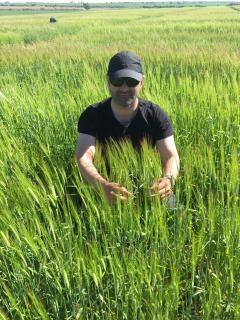Western Australia
September 11, 2019

DPIRD research officer Dr Hamid Shirdelmoghanloo assesses barley plants as part of a Western Barley Genetics Alliance project to better understand barley heat tolerance to help develop superior varieties suited to Australian heat-stressed environments.
A research project is examining if plump grain could be the key to breeding new barley varieties that are more tolerant to heat stress, improving crop productivity and profitability.
The pre-breeding research is being undertaken by the Western Barley Genetics Alliance, a partnership between the Department of Primary Industries and Regional Development and Murdoch University, with co-investment from the Grains Research and Development Corporation.
Department research officer Hamid Shirdelmoghanloo told the Australian Barley Technical Symposium this week, initial field trials provided encouraging results that could assist the development of new barley lines suited to Australian heat-stressed environments.
“Heat stress reduces grain plumpness and impacts the profitability of growing barley,” he said.
“This research seeks to determine the traits and mechanisms related to heat tolerance, which will help identify suitable germplasm and reliable screening tools essential for developing new heat tolerant barley varieties.”
Dr Shirdelmoghanloo said result trends from initial field trials suggested more than one adaptation process contributed to better grain weight and size under heat stress conditions.
“Generally, genotypes with plumper grain and higher individual grain weight tended to have higher maximum grain fill rate, longer grain filling duration and maintained green leaf area during grain filling when exposed to heat stress,” he said.
“A significant positive association was observed between stay-green plant characteristics and longer grain filling duration, which tends to suggest a link between the two plant traits.”
The results came from a field trial of 157 barley genotypes, grown at the department’s Wongan Hills Research Facility and a site at the Muresk Institute in 2018, using late sowing with irrigation to increase the probability of heat stress occurring during the grain filling period.
“As the number of days with maximum temperatures above 30 degrees during the grain filling period increases as our climate changes, so too does the risk of heat stress,” Dr Shirdelmoghanloo said.
“This research addresses this risk by developing a better understanding of heat tolerance and identifying reliable molecular markers that can be used by plant breeders to develop superior genotypes that are suited to Australian heat-stressed environments.”